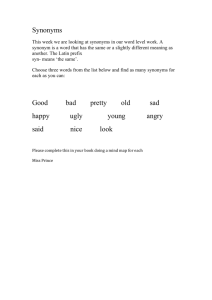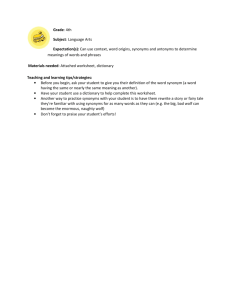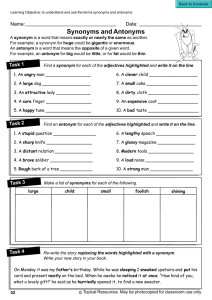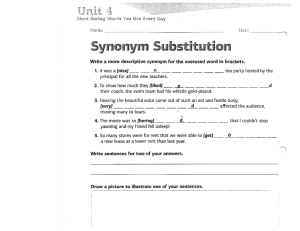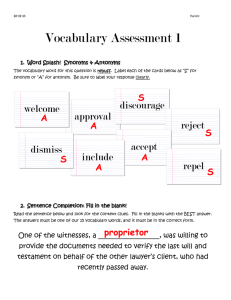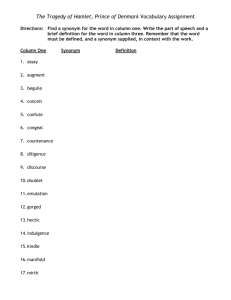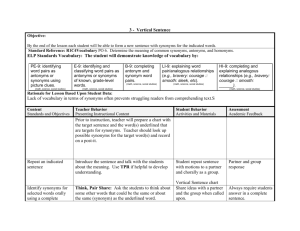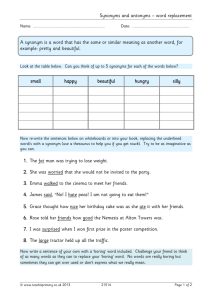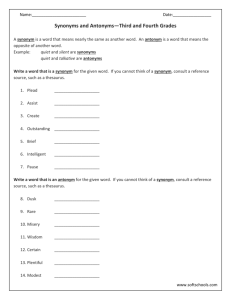Using cooccurrence statistics and the web to discover synonyms in a
advertisement
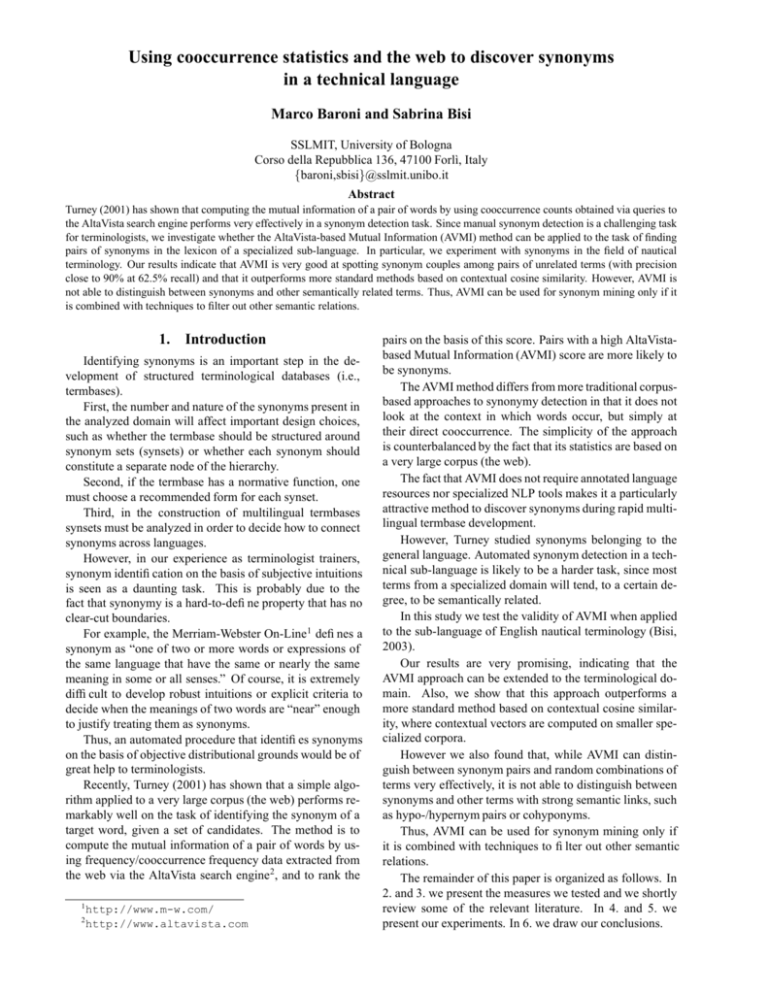
Using cooccurrence statistics and the web to discover synonyms
in a technical language
Marco Baroni and Sabrina Bisi
SSLMIT, University of Bologna
Corso della Repubblica 136, 47100 Forlı̀, Italy
{baroni,sbisi}@sslmit.unibo.it
Abstract
Turney (2001) has shown that computing the mutual information of a pair of words by using cooccurrence counts obtained via queries to
the AltaVista search engine performs very effectively in a synonym detection task. Since manual synonym detection is a challenging task
for terminologists, we investigate whether the AltaVista-based Mutual Information (AVMI) method can be applied to the task of finding
pairs of synonyms in the lexicon of a specialized sub-language. In particular, we experiment with synonyms in the field of nautical
terminology. Our results indicate that AVMI is very good at spotting synonym couples among pairs of unrelated terms (with precision
close to 90% at 62.5% recall) and that it outperforms more standard methods based on contextual cosine similarity. However, AVMI is
not able to distinguish between synonyms and other semantically related terms. Thus, AVMI can be used for synonym mining only if it
is combined with techniques to filter out other semantic relations.
1. Introduction
Identifying synonyms is an important step in the development of structured terminological databases (i.e.,
termbases).
First, the number and nature of the synonyms present in
the analyzed domain will affect important design choices,
such as whether the termbase should be structured around
synonym sets (synsets) or whether each synonym should
constitute a separate node of the hierarchy.
Second, if the termbase has a normative function, one
must choose a recommended form for each synset.
Third, in the construction of multilingual termbases
synsets must be analyzed in order to decide how to connect
synonyms across languages.
However, in our experience as terminologist trainers,
synonym identification on the basis of subjective intuitions
is seen as a daunting task. This is probably due to the
fact that synonymy is a hard-to-define property that has no
clear-cut boundaries.
For example, the Merriam-Webster On-Line1 defines a
synonym as “one of two or more words or expressions of
the same language that have the same or nearly the same
meaning in some or all senses.” Of course, it is extremely
difficult to develop robust intuitions or explicit criteria to
decide when the meanings of two words are “near” enough
to justify treating them as synonyms.
Thus, an automated procedure that identifies synonyms
on the basis of objective distributional grounds would be of
great help to terminologists.
Recently, Turney (2001) has shown that a simple algorithm applied to a very large corpus (the web) performs remarkably well on the task of identifying the synonym of a
target word, given a set of candidates. The method is to
compute the mutual information of a pair of words by using frequency/cooccurrence frequency data extracted from
the web via the AltaVista search engine2, and to rank the
1
2
http://www.m-w.com/
http://www.altavista.com
pairs on the basis of this score. Pairs with a high AltaVistabased Mutual Information (AVMI) score are more likely to
be synonyms.
The AVMI method differs from more traditional corpusbased approaches to synonymy detection in that it does not
look at the context in which words occur, but simply at
their direct cooccurrence. The simplicity of the approach
is counterbalanced by the fact that its statistics are based on
a very large corpus (the web).
The fact that AVMI does not require annotated language
resources nor specialized NLP tools makes it a particularly
attractive method to discover synonyms during rapid multilingual termbase development.
However, Turney studied synonyms belonging to the
general language. Automated synonym detection in a technical sub-language is likely to be a harder task, since most
terms from a specialized domain will tend, to a certain degree, to be semantically related.
In this study we test the validity of AVMI when applied
to the sub-language of English nautical terminology (Bisi,
2003).
Our results are very promising, indicating that the
AVMI approach can be extended to the terminological domain. Also, we show that this approach outperforms a
more standard method based on contextual cosine similarity, where contextual vectors are computed on smaller specialized corpora.
However we also found that, while AVMI can distinguish between synonym pairs and random combinations of
terms very effectively, it is not able to distinguish between
synonyms and other terms with strong semantic links, such
as hypo-/hypernym pairs or cohyponyms.
Thus, AVMI can be used for synonym mining only if
it is combined with techniques to filter out other semantic
relations.
The remainder of this paper is organized as follows. In
2. and 3. we present the measures we tested and we shortly
review some of the relevant literature. In 4. and 5. we
present our experiments. In 6. we draw our conclusions.
3. Context-based similarity: The cosine
approach
2. Cooccurrence-based similarity:
AltaVista-based Mutual Information
(Pointwise) Mutual Information (MI) was first introduced to computational linguistics by Church and Hanks
(1989). The mutual information between two words w1 and
w2 is:
M I(w1 , w2 ) = log2
P(w1 , w2 )
P(w1 )P(w2 )
(1)
There is a vast literature on MI applied to collocation
mining (Manning and Schütze, 1999, Ch. 5), and it is also
known that MI computed using large cooccurrence windows detects topically related words (Brown et al., 1990).
Turney (2001) has shown that MI computed on a very
large corpus (the web) and using a medium-sized cooccurrence window can be used to find synonyms. Evidently
(and somewhat surprisingly), synonyms have a tendency to
occur in the near of each other.
In particular, Turney uses AltaVista to collect occurrence and cooccurrence frequencies. The latter are computed using the AltaVista NEAR operator, which returns
pages in which the two target words occur within 10 words
of one another, in either order.
Turney applies the AltaVista-based Mutual Information
method to the TOEFL synonym match problem. The task
is to choose the synonym of a word from a set of four
candidates (e.g., for the target levied one has to choose a
synonym from imposed, believed, requested, correlated).
Turney’s algorithm picks the candidate that has the highest
AVMI with the target as the true synonym.
The AVMI method has a success rate of 72.5% on a
test set of 80 synonym match problems. This is particularly
impressive given that the average success rate of foreign
students taking the TOEFL is reported to be 64.5%, i.e.,
AVMI performs 8% better than the average test taker.
Terra and Clarke (2003) test MI and other measures on
the TOEFL synonym match task by extracting counts from
a very large web-derived corpus (53 billion words). Their
results confirm the effectiveness of MI which, with the best
parameter settings, reaches a success rate of 81.25%.
We compute AVMI using the following formula:
AV M I(w1 , w2 ) = log2 N
hits(w1 NEAR w2 )
hits(w1 )hits(w2 )
(2)
Here, hits(w1 NEAR w2 ) is the number of hits (documents) returned by AltaVista for a query in which the
two target terms are connected by the NEAR operator and
hits(wn ) is the number of hits returned for a single term
query. We set N , the number of documents indexed by AltaVista, to 350 millions.3
3
This is probably an obsolete estimate. However, the N term,
being constant, has no effect on the relative rank of pairs. For our
purposes, it functions as a scaling factor.
We compared AVMI to the more standard contextual
cosine similarity approach.4 For a detailed discussion of
this approach, which is based on the intuition that similar
words will tend to occur in similar contexts, see Manning
and Schütze (1999, sec. 8.5).
Contextual similarity is computed by building a vector
that collects the frequencies of cooccurrence of the target
words with all the words in the corpus, or with a subset of
these. The cosine of two normalized contextual vectors is
given by their dot product:
−
−
−
−
cos(→
x,→
y)=→
x ·→
y =
n
X
xi y i
(3)
i=1
The cosine ranges from 1, for perfectly correlated vectors, to 0 for totally uncorrelated vectors, to −1 for perfectly
inversely correlated vectors.
Notice that context-based methods, since they require
the construction of cooccurrence vectors for each target
word and the comparison of such vectors, are harder to
scale up to very large corpora than similarity measures
based on direct cooccurrence counts.
Latent semantic analysis (LSA) is a particularly sophisticated (and computationally intensive) version of the contextual similarity approach. Through dimensionality reduction techniques, LSA takes into account not only cooccurrence with the same words, but also cooccurrence with
words that are similar to each other.
Landauer and Dumais (1997) applied LSA to the
TOEFL synonym detection task with a success rate of
64.4%. This is comparable to the performance of the average foreign test taker (64.5%), but considerably lower than
the success rates attained by Turney and Terra and Clarke
(72.5% and 81.25%, respectively) with a simpler algorithm
and a much larger corpus (Landauer and Dumais used a
corpus of 4.7 million words).
In our experiments we computed cosine similarity
scores by collecting frequency counts from two corpora.5
The first corpus (described in detail by Bisi (2003)) contains about 1.2 million words and it is made of documents
that were hand-picked from the web and from paper sources
because of their representativeness of the domain of nautical terminology.
We also built a larger corpus (4.27 million words) via
automated queries for random combinations of nautical
terms to the Google search engine.6. By informal inspection, most documents in this corpus are valid examples of
4
It seems fair to compare AVMI to another knowledge-free
unsupervised measure. Moreover, while similarity measures relying on knowledge sources such as WordNet perform very well
(see, e.g., Budanitsky and Hirst (2001)), the relevant resources are
rarely available to terminologists, especially if they work on languages other than English.
5
We leave it to further research to develop a context-based
model based on AltaVista-derived statistics, and possibly to experiment with LSA.
6
http://www.google.com
the specialized language under investigation.7
Before collecting context vectors, we removed the 200
words that have the highest document frequency in the
Brown corpus (Kučera and Francis, 1967) from both corpora. These are mostly function words. All other words
were treated as potential dimensions of the similarity vectors.
Context vectors were collected using two relatively narrow windows: 2 words to either side of the target and 5
words to either side of the target. In both cases, words that
cooccurred only once with a target were not counted.
In what follows, we use the following codes for the contextual cosine measures: COST2 (counts from the terminologist’s hand-picked corpus, 2-word window), COST5 (terminologist corpus, 5-word window), COSW2 (web corpus,
2-word window) and COSW5 (web corpus, 5-word window).
We also experimented with combinations of direct
cooccurrence and context similarity scores. We will only
report results for the best performing combination, which
was obtained by summing the ranks of the pairs in the lists
ordered by AVMI and COSW2.
4.
Synonym pairs vs. random pairs
In the first experiment, we use AVMI and cosine similarity to look for synonyms among random pairs of terms
from the same domain.
4.1. Test set
The 148 word test set contains the 24 synonyms pairs
included in the termbase of Bisi (2003) (pairs such as bottom/hull, frames/ribs, displacement/weight) and 124 nonsynonym pairs. 24 of these were created by re-combining
the terms in the synonym set (in order to control for possible
term-specific effects). The remaining 100 pairs were constructed by forming random couples of 200 nautical terms.
Since all the non-synonym pairs belong to the same domain, they are all, at the very least, topically related, and
they often have stronger semantic links. Before running our
tests, we classified the random pairs into strongly semantically related vs. not (strongly) related, on the basis of our
intuition and knowledge of the domain. We judged 36 pairs
(29%) to be formed by strongly semantically related terms.
Examples of such pairs include decks/cockpit, awning/stern
board, install/hatch, keel/coated and underway/cruising. 8
Synonym detection in this setting is clearly a harder task
than if the non-synonym pairs had been taken from general
vocabulary.
4.2. Results and discussion
Table 1 reports percent precision at eight recall levels
for the various similarity measures.9
7
The tools we used to build this corpus are now available as
the BootCat Tools (Baroni and Bernardini, 2004).
8
The list did not contain any pair that could be categorized
in terms of synonymy, hyponymy or other standard relations
recorded in our termbases.
9
In the case of ties, we treated synonym pairs as if they were
ranked below non-synonym pairs.
AVMI is by far the best measure, outperforming all the
context-based measures and the AVMI/COSW2 combination. At a recall of 62.5% (15 synonym pairs found over 24
present), AVMI has still a precision of 88.2%, i.e., only 2
non-synonym pairs are mixed with the synonyms.
This is a very promising result, confirming that the direct cooccurrence method applied to a very large corpus
outperforms the context-based method applied to smaller
corpora, and that the web is a large enough corpus that this
is true even if we are dealing with terms from a specialized
domain.
Among the variants of the context-based approach, the
ones using a narrower window perform better, but they have
worse data scarcity problems, with big tails of synonym
pairs that are at the bottom of the list because they are made
of terms with extremely sparse, non-overlapping vectors.
The contextual measures derived from the terminologist corpus outperform those based on the web if we look
at the top of the lists, but, as recall increases, their precision
drops faster to values close to or below chance level, reflecting the quality/quantity tradeoff that we expect between a
smaller hand-built corpus and a larger automatically constructed one.
Interestingly, by inspecting the 31 false positives (nonsynonym pairs) that we get at the 75% recall level in the
AVMI list, we find that 14 of them (about 45%), are among
the pairs that we judged to be strongly semantically related
(see previous section). This is 16% higher than the proportion of strongly related pairs in the whole list of nonsynonyms (29%).
Thus, a consistent portion of the “rivals” of the synonyms are pairs with strong semantic links of other kinds.
This suggests that the MI method is detecting semantic relations in general, and not synonymy in particular.
5. Synonym pairs vs. other semantically
related pairs
To further explore the issue raised at the end of the previous section, we ran a second experiment in which the test
set was modified to systematically include other types of
semantically related words.
5.1. Test set
We added 31 more pairs from the Bisi termbase to the
test set described in 4.1. Of these, 19 are cohyponym pairs
(e.g., Bruce anchor/mushroom anchor, flexible tank/rigid
tank), 10 are hypo-/hypernym pairs (e.g, stern platform/sun
deck, awning/canopy) and 2 are antonyms (ahead/astern,
aboard/overboard). The cohyponym and hypo-/hypernym
pairs include all the instances of these relations in the
termbase that share one term with one of the synonym pairs.
The antonym pairs are the only two pairs of this type in the
termbase.
In order to maintain the same synonym-to-nonsynonym ratio as in the first experiment, we removed 31
randomly picked non-synonym pairs from the test set.10
10
We repeated the experiment by removing different random
subsets, and we consistently obtained results similar to those we
report.
recall
3 (12.5%)
6 (25%)
9 (37.5%)
12 (50%)
15 (62.5%)
18 (75%)
21 (87.5%)
24 (100%)
AVMI
100
100
90
92.3
88.2
36.7
30.4
16.2
COST2
100
75
42.9
17.9
10.8
12.7
14.5
16.2
COST5
60
60
39.1
19.4
15
12.7
14.5
16.2
COSW2
60
46.2
40.9
26.7
19
12.7
14.5
16.2
COSW5
42.9
46.2
45
25.5
17.6
13.4
14.5
16.2
COMB
100
66.7
52.9
41.4
27.3
23.4
23.3
16.2
Table 1: Synonyms vs. random pairs: Percentage precision at 8 recall levels.
recall
3 (12.5%)
6 (25%)
9 (37.5%)
12 (50%)
15 (62.5%)
18 (75%)
21 (87.5%)
24 (100%)
AVMI
60
33.3
36
40
37.5
26.5
25.6
16.2
COST2
42.9
46.2
39.1
19.7
10.8
12.7
14.5
16.2
COST5
37.5
46.2
39.1
21.1
17.4
12.7
14.5
16.2
COSW2
27.3
28.6
29
23.1
19.2
12.7
14.5
16.2
COSW5
20
27.3
31
22.6
18.1
14.1
14.5
16.2
COMB
25
27.3
31
29.3
24.6
22.8
21.4
16.2
Table 2: Synonyms vs. random and related pairs: Percentage precision at 8 recall levels.
5.2. Results and discussion
Table 2 reports percent precision at eight recall levels
with the modified test set.
AVMI is still the best measure (at most recall levels), but
its performance has dropped dramatically. This confirms
that AVMI is good for finding semantically related terms
in general, but it does not single out synonyms when other
strongly related terms are present.
The drop in performance is due to the combined effect of hypo-/hypernymy and cohyponymy. For example,
among the top 40 pairs in the ranked AVMI list we find 15
synonym pairs, 15 cohyponym pairs and 8 hypo-/hypernym
pairs, for a total of 38 “nymic” pairs. The two antonyms are
not interfering with synonym detection, as they are at ranks
47 and 146, respectively.
Performance of the cosine-based and combined measures did not drop as much as that of AVMI, but this is
probably due to a “flooring” effect.
6. Conclusion
Our study confirms the effectiveness of mediumdistance MI measured on a very large corpus as a semantic
similarity measure, extending the results of Turney (2001)
and Terra and Clarke (2003) to a technical domain, where
all terms tend to a certain extent to be related, and thus the
task of identifying the most similar terms becomes harder.
However, our results also suggest that AVMI is a good
measure to find semantically related pairs in general, not
synonyms in particular.
The impressive results of Turney (2001) and Terra and
Clarke (2003) are probably due to the fact that in most of
their synonym candidate sets the true synonym was the only
word to be semantically related to the target.
To turn AVMI into a full-fledged synonym mining technique, it is necessary to find ways to filter out other types
of “nyms” from the results. This step can be performed
manually by a terminologist (discovery of hyponymy and
cohyponymy is not seen as a particularly challenging task).
Alternatively, the process of filtering out semantically related non-synonyms could be automated.
Turney (2001) and Lin et al. (2003) collect web-based
cooccurrence statistics with special queries that are biased
against antonyms. In future research, we plan to extend
their approach, by developing special queries that disfavor
other nymic relations and/or favor synonym detection.
7.
References
M. Baroni and S. Bernardini. 2004. BootCaT: Bootstrapping corpora and terms from the web. LREC 2004.
S. Bisi. 2003. Verso una terminologia descrittiva nel
quadro di un approccio apertamente linguistico: ricerca
terminologica bilingue italiano-inglese nel campo dello
yacht a motore. Tesi di Laurea, SSLMIT.
P. Brown, V. Della Pietra, P. DeSouza, J. Lai, and R. Mercer. 1990. Class-based n-gram models of natural language. Computational Linguistics, 18:467–479.
A. Budanitsky and G. Hirst. 2001. Semantic distance in
WordNet: An experimental, application-oriented evaluation of five measures. Proceedings of Workshop on
WordNet and Other Lexical Resources of NAACL 2001.
K. Church and P. Hanks. 1989. Word association norms,
mutual information, and lexicography. ACL 1989, 7683.
H. Kučera and N. Francis. 1967. Computational analysis of present-day American English. Brown University
Press.
T. Landauer and S. Dumais. 1997. A solution to Plato’s
problem: A latent semantic analysis theory of the acquisition, induction and representation of knowledge. Psychological Review, 104:211–240.
D. Lin, S. Zhao, L. Qin, and M. Zhou. 2003. Identifying
synonyms among distributionally similar words. IJCAI
2003.
C. Manning and H. Schütze. 1999. Foundations of statistical natural language processing. MIT Press.
E. Terra and C. L. A. Clarke. 2003. Frequency estimates
for statistical word similarity measures. HLT-NAACL
2003, 165–172.
P. Turney. 2001. Mining the web for synonyms: PMI-IR
versus LSA on TOEFL. ECML 2001, 491–502.
